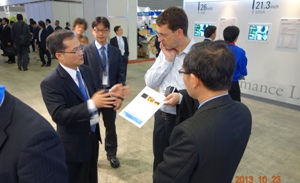Oct 25 2013
One of the most closely-watched exhibits at FPD International 2013 in Yokohama during October 23-25 was the joint announcement by Taiwan's ITRI and Japan's Komori International of a completely new fine-line printing technology.
The technology replaces the need of seven different pieces of equipment with a single direct-printing station. It enables printing of less than 10µm fine metal lines and enhances material utilization from 10% to 90%.
 Dr. C.T. Liu, Vice President and General Director of Electronics and Optoelectronics Research Laboratories, ITRI, noted that the world-famous enterprises have expressed their interest in working jointly on the production, facility, material development, or fine-line printing, ultra-thin substrates, and metal-mash associated with the roll-to-roll technology.
Dr. C.T. Liu, Vice President and General Director of Electronics and Optoelectronics Research Laboratories, ITRI, noted that the world-famous enterprises have expressed their interest in working jointly on the production, facility, material development, or fine-line printing, ultra-thin substrates, and metal-mash associated with the roll-to-roll technology.
On the first day, ITRI and Komori's joint booth was flooded by numerous interested international visitors, including material and display corporations, manufacturers, and suppliers such as Beijing Oriental Electronics, JDI, NEG, Asahi Glass, Toray, Tokki, Hirano and Applied Materials. They came for inquiry and were amazed by ITRI's ultra fine-line printing technology. Dr. C.T. Liu, Vice President and General Director of Electronics and Optoelectronics Research Laboratories, ITRI, noted that these world-famous enterprises have expressed their interest in working jointly on the production, facility, material development, or fine-line printing, ultra-thin substrates, and metal-mash associated with the roll-to-roll technology.
Existing screen printing techniques can achieve line widths of about 60-80µm in mass production, while lithography and etching make it possible to reach 30-50µm. With the Komori-ITRI's innovative roll-to-roll design, precision printing technology in touch panel production breaks through these barriers to 10µm or less. This approach replaces the expensive photolithography process and eliminates seven machines needed for conventional sputtering, resist-coating, baking, exposure, developing, etching, and stripping. Instead, a single process of direct printing of fine metal lines on ultra-thin substrates enables high-efficiency mass production of touch panels for smart-handheld devices.
Dr. Liu added that when the technology first debuted at Touch Taiwan in August this year, many vendors desired to apply it to their production lines. Now with Komori and ITRI working together for the past two months, printing of fine lines has taken a significant leap from 20µm to less than 10µm, on various substrate widths ranging from 300mm to 500mm. The overall printing process uses a "full version" design that dramatically improves material utilization, with mass production expected to come next year.